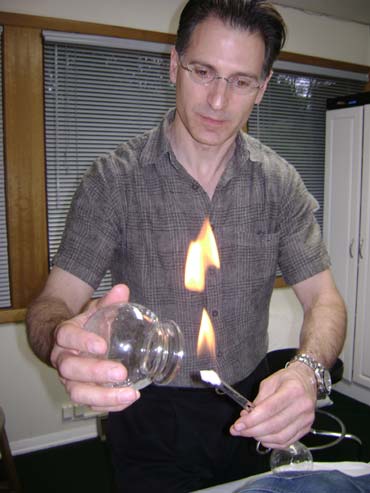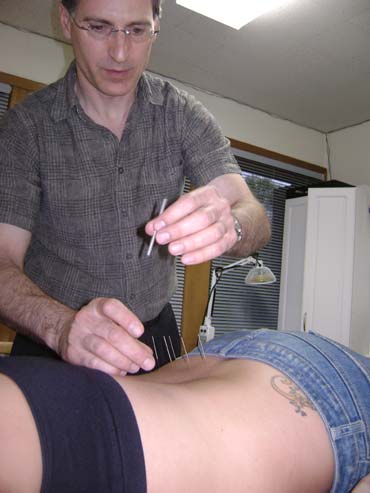
Alternative medicine gains ground in central Pa.
by Michele Russell
A series of long, thin needles balances along the spine. A slight tensing of the muscles from the insertion of the dozens of needle points turns into a tingling sensation, followed by the release of the needles being removed one at a time.
It’s not exactly what some would consider the first choice in pain relief, but acupuncture and other unconventional medical treatments may be taking root in Centre County.
Alternative medicine refers to treatments that don’t involve surgery or prescription drugs. Alternative medical practices like chiropractic, acupuncture, biofeedback, homeopathy, naturopathy and therapeutic massage often deal with the complete mind-body relationship of the patient, rather than treatment of acute physical problems, practitioners say, and most are available locally.
Daniel Greenberg, a licensed traditional Chinese medicine practitioner, performs acupuncture on his patients to relieve 50 different conditions, not all of which are associated with physical pain like arthritis or back aches. Acupuncture can be used to treat insomnia, anxiety, hypertension and other conditions associated with brain function.
The body is composed of a concentration of bioenergy called Qi (pronounced chee), which, when disrupted, causes both physical and mental ailment, according to information from Greenberg’s office. Acupuncture is used to correct this disruption.
Acupuncture is just one form of alternative medicine that has been expanding in Centre County.
Nittany Health Center’s Deborah Klein, who practices holistic healing methods in Centre Hall, said the marginalization of alternative medicine comes from the value placed on scientific fact.
“The modern medical community is highly scientific, whereas alternative health care and holistic healing are still being quantified,” Klein said, adding, “I don’t need to use the science to see the effect of what I do for my clients.” Klein’s practice includes Reiki massage, which involves moving the body’s energy; hypnosis; and shamanic and angelic practices.
But can shamanic practices fix a sprained ankle? No. Klein said she values the medical profession when it comes to immediate patient care.
“In cases of acute trauma, medical professionals are very helpful,” she said, “because often [alternative medical providers] don’t have the necessary skills or tools to heal, say, a broken and protruding bone.”
A search of an Internet business directory for alternative medicine in Centre County yields more than 1,000 results. The industry seems to be growing, but few Pennsylvania health insurance providers include alternative medicine in their coverage.
“For the short time alternative medicine has been in Pennsylvania, it has become more and more accepted and less of a mystery,” Greenberg said. “And a lot of it has to do with greater visibility and word of mouth exposure. It still is a bit mysterious, but it is no longer unknown.”
Chiropractic and massage therapy are the most accepted under the few health care plans that provide alternative medicine coverage or reimbursement, according to the National Center for Complementary and Alternative Medicine, and consumer interest is prompting insurance companies to consider others, the group claims. Still excluded are acupuncture; homeopathy, which treats ailments using small amounts of venom; naturopathy, which uses natural remedies; and biofeedback, which measures the body’s functions.
Three major Pennsylvania health insurance providers, Highmark, Aetna and Keystone Mercy, offer coverage for chiropractic but not any other form of alternative medicine.
“It’s still alternative if it’s not a primary care physician,” explained Cindy Love of chiropractic. Love is the office manager for her husband Roy’s State College–based chiropractic practice. She said some insurance plans require the chiropractor to be the patient’s primary care physician, and some have other restrictions.
But wasn’t there a time insurance companies didn’t cover chiropractic?
“They always have, but now they’re much more open,” Love said. “It’s very rare that an insurance company does not cover chiropractic.” She explained that it’s an issue of licensing. Chiropractors are licensed in every state, but massage therapists, among others, are not licensed in Pennsylvania.
She added that insurance companies still consider acupuncture and other forms of alternative medicine “experimental,” but that the military’s insurance company, TriCare, which hadn’t even covered chiropractic until recently, is now covering it in Virginia in something akin to a pilot program.
Greenberg said the fault is with the industry.
“People need to complain to their insurance and health care providers if they want to see a change [in alternative health care coverage],” Greenberg said.
“I think some of the criticism [surrounding alternative medicine] is that it hasn’t gone through clinical trials, but it has. They just aren’t what the medical professional community sees as the standard,” Greenberg said. “I think that [alternative medicine’s] practice over thousands of years alone is the clinical trial that helps to prove its effectiveness.”
Traditional Chinese medicine has been practiced for more than 2,000 years, with rich influences from both Asian and European countries, according to the Alternative Medicine Foundation, a national nonprofit that offers information about alternative medicine. It expanded continuously in China until the early 1900s, when modern Western medicine was being pioneered. Alternative medicine began seeing popularity in the United States in the 1970s, after Chinese-American ties became stronger.
Klein, who earned her degree in rehabilitation education from Penn State, said her goal as a practitioner is to “unite mind, body and spirit, offering my clients whole person healing.” She added that her treatments require that her clients meet her in the middle.
“You are your own healer,” she said.
Klein and Greenberg acknowledged the responsibility of alternative medicine practitioners to understand Western medicine in their treatments, just as they said Western medical practitioners should attempt to understand alternative practices.
“It is important for me to understand what my client’s doctors are diagnosing, even if there is no Eastern medical name for it, and I need to understand the prescription drugs my clients are using when recommending herbal remedies,” he said. “People come in on 16 to 20 prescriptions, and my ultimate goal is to slowly reduce those medications through treatments so they feel better. The body will eventually take over the supportive actions that the prescriptions work to replace.”
The difference between modern and alternative medicine, aside from the significance of clinical trials and science, is the approach to the body as parts or as a whole, these practitioners said.
“Western medicine has a history of reductionism and focuses on singular mechanisms within the body, whereas Eastern medicine looks at the nature of the entire body, which is always in dynamic change,” Greenberg said. “The relationship of the anatomy is not static, it’s dynamic.”
Both Klein and Greenberg said modern and alternative medical practices are not in competition with one another.
“When either side is looking at all or nothing, we don’t achieve the higher goal of creating a bridge between the two,” said Klein, adding that the bridge between alternative and modern medicine has yet to be built. “We [as a medical community] want people to have choices.”

Photos by Brittany Reutzel
More and more central Pennsylvanians are trying new treatments, including acupuncture, to get and stay healthy. Above, local acupuncturist Daniel Greenberg inserts needles into a patient’s lower back.
Comments
Be sure to get your facts straight
First of all, since one of the big issues in natural and alternative health is teaching people what its all about, this author need to make sure they protray the methods properly. Homeopathy is not the use of small amounts of venom. It is the use of diulte substances used to treat a variety of conditions. I would refer people to this site or others to learn more about homeopathy. http://en.wikipedia.org/wiki/Homeopathy . To follow up, a technique that does use small amounts of Bee venom is apitherapy.
It is great to see that the alternatve medicine field is growing in central PA. As a Penn State graduate from the Biobehavorial Health program I began to learn abou the alternative medicine field and the challenges that lay ahead for PA, its good to see that times a changing.
Thanks for clarifying
Thanks for clarifying that fact. We'd run a correction in the print version but it's been a long time since we ran this story. Your clarification here will help those who use the online version.
Voices is an all-volunteer paper and we rely on the work of writers from young amateurs to mature professionals, but mostly the former. We don't catch everything - far from it - but we always hope our readers will be understanding until we can draw professionals to report for us by paying them.
Standard reporting wisdom doesn't allow us to count on a source such as wikipedia...but if you have some others, perhaps some day we can do a follow up story. Thanks again -
Suzan Erem, Managing Editor
Homeopathy Resources
A good resource is http://nccam.nih.gov/health/homeopathy/ is is operated through the National Center for Complimentary and Alternative Medicine NCCAM through the Natgional Institutes of Health. Their main webiste http://nccam.nih.gov/ has a large number of resources on different treatment modalities.
Jacob